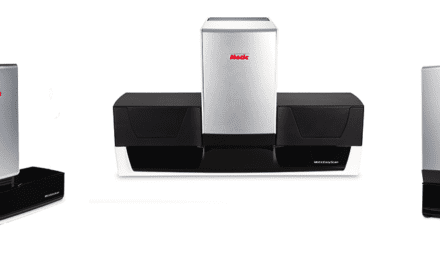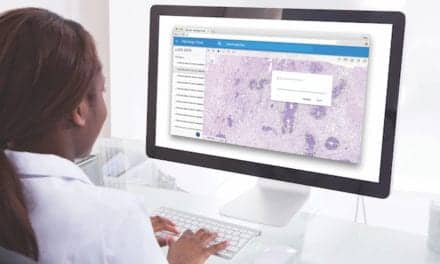Artificial intelligence promises gains in efficiency and accuracy for clinical laboratories
By Avi Veidman
Amid the growth and greying of the world’s populations, demand for pathology services is soaring. Faced with such a rapidly growing workload at the same time that its workforce is shrinking, the profession of pathology is ripe for disruptive innovations designed to improve the lives of both patients and physicians. The integration of pathology practices with artificial intelligence-based solutions offers a pathway for better matching supply and demand while delivering more-accurate and effective diagnostic care.
Relatively speaking, the field of artificial intelligence is still in its infancy. But already, practitioners have demonstrated that artificial intelligence-based systems have the potential to play a central role in addressing many of the most vexing challenges in healthcare—including overwhelming workloads and inexorably rising costs. Opportunities for artificial intelligence to make a contribution to improving healthcare extend far and wide, but the opportunities related to the practice of modern pathology offer an especially illuminating view of the truly groundbreaking potential of the latest technologies to emerge onto the healthcare scene.
Alleviating the Bottleneck
While pathologists’ workloads are increasing in the here and now, forecasts for the pathology profession point to a situation that promises to become even more critical in a very short time. A recent study projected that by 2030, there will be as much as 30% fewer working pathologists relative to 2010 figures.1
Within pathology’s niche cases, the picture is similarly bleak. Poorer and more remote areas are especially prone to specialist shortages. The World Health Organization notes that in 2017, a scant 26% of low-income countries had ‘generally available’ pathology services in their public sector health systems, presenting a major challenge for treating infections and major maladies like cancer.2
One important trend that is contributing to the shortage of pathology specialists is the aging and retirement of senior members of the profession, contributing to a predicted decline in pathologists to 3.7 per 100,000 people by 2030. Meanwhile, demographic, environmental, and lifestyle factors are sending demand ever higher for key services, including biopsies. Given this dynamic, annual demand for pathologists in the United States is expected to reach 20,000 in the intermediate term, while the projected supply will be less than 15,000 (Figure 1).1

Figure 1. Field experts have projected a rising need for pathologists in the United States and worldwide. Annual demand for pathologists in the United States is expected to reach 20,000 in the intermediate term, while the projected supply will be less than 15,000.1
By embracing the application of artificial intelligence to pathology operations, laboratories may be able to forestall or even eliminate some of the projected challenges facing the field. But while artificial intelligence has the potential to break boundaries in pathology capabilities, large swaths of the pathology workforce still lack the training necessary to work effectively with such diagnostic aids. Such limitations in the skillsets of current pathology professionals underscore the conclusion that the technological solutions supported by artificial intelligence systems will truly be of value to the pathologists of the future if the profession increases its emphasis on artificial intelligence skills training in the present.
AI as a Lab Partner and Doctor’s Aid
The incentives for overcoming the barriers to implementing artificial intelligence systems are compelling. Start with the paramount importance of medical imaging—the source of 90% of all healthcare data. Medical images generate reams of information—but as much as 97% of it isn’t analyzed or used for clinical purposes.3 Trained on algorithms exposed to a rich variety of pertinent diagnostic data, artificial intelligence-based digital image assessment tools can analyze such images with unparalleled accuracy, extracting vital insights with remarkable efficiency and ensuring that all of the relevant data they generate is put to valuable clinical use.
For artificial intelligence specialists seeking to boost commercialization of their products and services for pathology laboratories, the growing need for sophisticated technological tools presents a world of opportunities. One promising pathway for engaging the healthcare workforce is through ‘smart labs’ in which human professionals make extensive use of the emerging tools of artificial intelligence and data analytics.
Hospitals are increasingly instituting smart labs as a means of improving the technical flows of their existing clinical and pathology labs and enabling pathologists to attend to more cases per day—all with greater accuracy and at lower cost, and while placing less strain on the human professionals at the heart of the medical profession. Given such wide-ranging benefits, artificial intelligence-based diagnostics are becoming an increasingly competitive market, presaging a future in which such tools aren’t merely nice to have, but integral to labs’ operations.
In healthcare as in many other fields, the nature of work is undergoing profound transformations. Adopting machine learning and artificial intelligence strategies can help laboratorians to resolve some of the key pain points in today’s work environments, including work overload and human error (two separate but not unrelated phenomena). And by making use of such advanced tools, the pathology workforce will suffer from less stress—and be better able to perform advanced diagnostic testing and contribute to improved patient care.
Prognosis and Misdiagnosis
The implementation of artificial intelligence tools will be no less a game-changer for patients—and particularly for those suffering from serious health conditions. In the United Kingdom alone, two in five cancer patients receive at least one inaccurate diagnosis before their illness is correctly identified (Table 1).4 With artificial intelligence-based diagnostic tools able to assess biopsies in a way that exceeds the performance of a human working alone, artificial intelligence has the potential to be more than a game-changer—for many patients, it can prove to be a life saver.5

Table 1. Pathologists can make mistakes. In a review of initial cancer diagnoses and their correlation with a second review, pathologist errors resulted in significant discrepancies for several types of cancer. Such errors in diagnosis often lead to expensive and grueling courses of treatment that are not ultimately beneficial for the patient’s health.
The adoption of artificial intelligence tools will also be a major cost-saver. Errors in diagnosis often lead to expensive and grueling courses of treatment that are not ultimately beneficial for the patient’s health. Each year, for example, an estimated 8,415 patients suffering from Stage II colon cancer receive nonbeneficial chemotherapy treatments; and given the total cost of roughly $387.1 million, such treatments come at a significant price to both patients and the healthcare system at large. Because artificial intelligence systems can help to provide a more complete and accurate analysis of a patient biopsy than a human professional working alone, such systems can also help clinicians and patients avoid overtreatment and respond to illnesses in a more targeted, effective manner.
Meanwhile, as pathologists and clinicians work toward achieving the goals of personalized medicine, artificial intelligence is proving to be an indispensable asset for forging the customized healthcare landscape of the future. As datasets grow, smart laboratories will be able to adapt their diagnostic and monitoring activities according to each patient’s unique profile, and smart hospitals will be able to modify patient treatment protocols using automated analyses of personalized diagnostic information.6
Moreover, clinics will be able to use artificial intelligence that is tailored to their own specific workflow and clinical needs. With an ability to quickly develop new indications for use, clinics can use artificial intelligence tools to develop relevant solutions according to their need, and to further adapt the artificial intelligence tools to best suit their methods of clinical analysis.
Thanks to advances in digital image analysis, whose technology is backed by machine learning based on exposure to millions of digitized whole-slide images, artificial intelligence will ultimately enhance the ability of pathologists to provide more accurate information in a much shorter amount of time. One day soon, growing databases may be able to identify new clinical trials and therapy options for patients even before they have been widely publicized.
Conclusion
For a declining workforce that nevertheless faces mounting workloads, artificial intelligence will be a necessary and transformative part of the future of pathology. For some, the goal of implementing artificial intelligence-based diagnostic tools may be to eliminate the need for human professionals. But in the view of our organization, artificial intelligence is better used to augment the work of highly trained pathology professionals than to replace them.
The gap between the demand of the global healthcare market and the supply of pathology professionals points to the pressing need to embrace artificial intelligence technologies. From whichever angle one approaches the question, the ability of articial intelligence systems to alleviate the strains on clinical professionals, and to deliver better, more accurate, and more effective healthcare makes migrating toward artificial intelligence solutions seem essential.
Avi Veidman is founder and CEO of Nucleai. For further information, contact CLP chief editor Steve Halasey via [email protected].
References
- Robboy SJ, Weintraub S, Horvath AE, et al. Pathologist workforce in the United States: I. development of a predictive model to examine factors influencing supply. Arch Pathol Lab Med. 2013;137(12):1723–1732; doi: 10.5858/arpa.2013-0200-oa.
- Cancer [factsheet, online]. Geneva: World Health Organization, 2018. Available at: https://www.who.int/news-room/fact-sheets/detail/cancer. Accessed April 17, 2019.
- Beyond imaging: the paradox of AI and medical imaging innovation [online]. Chicago: GE Healthcare, 2018. Available at: http://newsroom.gehealthcare.com/beyond-imaging-ai-imaging-innovation/. Accessed April 17, 2019.
- Matthews-King A. Four out of 10 cancer patients initially misdiagnosed, finds report warning of pressures in testing [online]. The Independent, December 4, 2018. Available at: www.independent.co.uk/news/health/cancer-diagnosis-missed-gp-referral-testing-treatment-report-nhs-a8665636.html. Accessed April 17, 2019.
- Wiggers K. Google AI claims 99% accuracy in metastatic breast cancer detection [online]. VentureBeat, October 12, 2018. Available at: https://venturebeat.com/2018/10/12/google-ai-claims-99-accuracy-in-metastatic-breast-cancer-detection. Accessed April 17, 2019.
- First cost-effectiveness study of multigene panel sequencing in advanced non-small cell lung cancer shows moderate cost-effectiveness, exposes crucial practice gap [press release, online]. Washington, DC: Personalized Medicine Coalition, 2019. Available at: www.personalizedmedicinecoalition.org/news/press_releases/first_costeffectiveness_study_of_multigene_panel_sequencing_in_advanced_nonsmall_cell_lung_cancer_shows_moderate_costeffectiveness_exposes_crucial_practice_gap. Accessed June 26, 2019.





